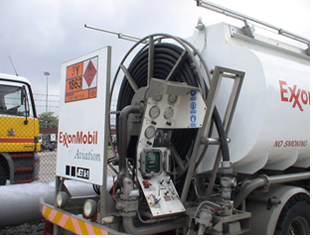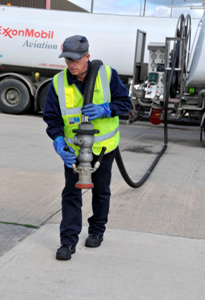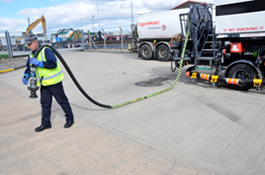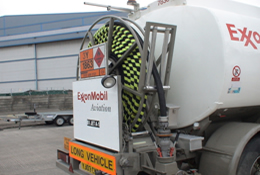This case study provides an example of good practice to reduce the manual handling risks (pull forces) present when unravelling fuel hoses prior to refuelling aircraft.
The issue
Employees engaged in aircraft refuelling operations are required to manually remove the refuelling hose from the rear of the fuelling truck (see figure one below). The refuelling hose is generally pulled a distance of 8 metres but in some circumstances can be pulled a distance in excess of 15 metres. Employees would remove the hose nozzle from the fuelling vehicle and place the nozzle and hose over their shoulder and walk forwards to the hose's destination and unravel the hose from its wheel (see figure 2).
Figure 1

Figure 2

ExxonMobil, via Manual Handling Risk Assessment process identified concerns regarding the pulling forces required to unravel the fuel hoses from the vehicle particularly when the 'sagging' unravelled hose (see figure 2) makes contact with the concrete floor increasing the friction and therefore the pulling force required to extend the hose. As the hose is pulled out more of the hose makes contact with the concrete and therefore the forces required to pull the hose continues to rise.
ExxonMobil recognised that the forces required to pull the hose may be beyond the pulling force capabilities of some employees and therefore may represent a risk of musculoskeletal injury. Furthermore it was recognised that employees were leaning forwards in order to overcome the forces required to unravel the hose therefore possibly increasing the slipping potential particularly in cold weather periods. This activity will take place during hours of darkness so therefore employees may be unable to identify potential slip hazards.
What we did
ExxonMobil devised an improvement in order to reduce the forces required to unravel the hose. This involved wrapping hard, low-friction plastic around the hose in a helical manner so that when the hose makes contact with the floor there is less friction and consequently the forces required to drag the hose are reduced. This is shown in figure 3 and 4 below. The helical wrapping was cut into 2m lengths, so that parts that wore could be replaced without having to replace the whole hose length of wrapping. The colour of the wrapping was also specifically manufactured to enhance the visibility whilst in use on the apron, this allowed other airside users both in vehicles and on foot to identify where the hose had been lay and as such avoid both a tripping hazard and from being driven over.
Figure 3

Figure 4

ExxonMobil contacted the HSE and sought their opinion on this musculoskeletal injury risk reduction measure. As a result HSE's research laboratories (The Health and Safety Laboratory) measured the forces required to pull the hoses both with and without the plastic wrapping.
The forces required for pulling the hose over a time period are shown in Graph 1 below. However the forces to pull the hose without the plastic wrapping were so high and still increasing that measurements were not taken once 17 meters had been unreeled.
Graph 1 - Measured forces for wrapped and unwrapped hose
The Manual Handling Operations Regulations 1992 (as amended) (MHOR) place duties on employers to reduce hazardous manual handling risks as far as is reasonably practical. MHOR defines manual handling as 'any transporting or supporting of a load (including the lifting, putting down, pushing, pulling, carrying or moving thereof) by hand or by bodily force.'
Peak forces without the plastic wrapping as high as 568N (56.8kgF), were measured which is beyond the capability of the majority of working males.
The graph shows the pulling forces are reduced when the refuelling hose is wrapped with plastic therefore reducing the physical demands on the employee when performing this task. In fact the average and maximum task forces with the wrapped hose were considerably less than those with the unwrapped hose by 22.4% and 25.1% respectively.
The MHOR established a clear hierarchy of measures which are to:
- Avoid hazardous manual handling so far as is reasonably practical
- Make a suitable and sufficient assessment of any hazardous manual handling operations that cannot be avoided
- Reduce the risk of injury from those operations as far as is reasonably practical
Therefore by attaching the plastic wrapping to the refuelling hoses the forces required to perform the refuelling operation is substantially reduced and therefore the physical demands on the employees are substantially reduced.
Other advantages of wrapping the refuelling Hose
- Due to the reduction in the force required to unravel the hose from the reel operatives' postures were improved when performing the task (ie not leaning forward to overcome the force required)
- Reduced potential for slipping in cold weather conditions due to the improved posture
- Less biomechanical and physiological demands on the worker over the working day due to the reduction in force requirements
- Wear and tear on the hose is reduced as it is not in direct contact with the ground, without the wrapping the hoses have to be cut and shortened where key wear points are identified
- The time taken to carry out the operation is also likely to be reduced
The cost to wrap a refuelling hose is as little as £120 per hose!!
The Health and Safety Executive (HSE) considers this intervention a reasonably practical control measure for reducing the risk of manual handling injury when refuelling aircraft and would encourage the industry to adopt a similar approach.